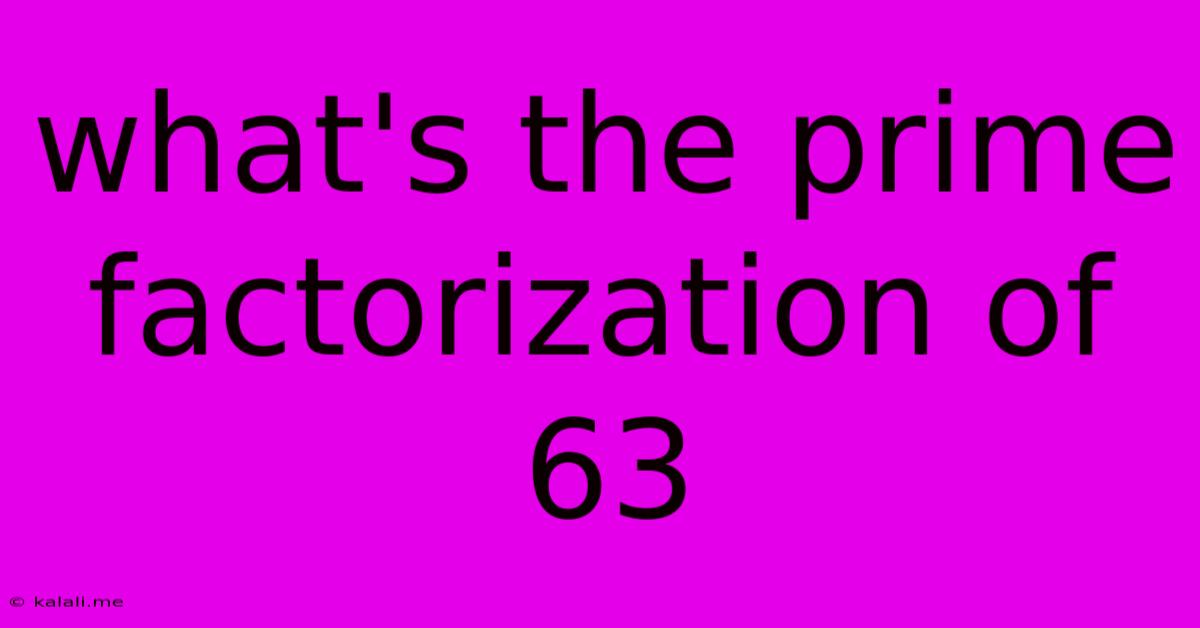What's The Prime Factorization Of 63
Kalali
Jun 15, 2025 · 3 min read

Table of Contents
What's the Prime Factorization of 63? A Step-by-Step Guide
Finding the prime factorization of a number is a fundamental concept in mathematics, crucial for understanding various mathematical operations and applications. This article will guide you through the process of determining the prime factorization of 63, explaining the method clearly and concisely. Understanding prime factorization can help with simplifying fractions, finding the greatest common divisor (GCD), and solving more complex mathematical problems.
What is Prime Factorization?
Prime factorization involves expressing a number as a product of its prime factors. A prime number is a whole number greater than 1 that has only two divisors: 1 and itself. Examples of prime numbers include 2, 3, 5, 7, 11, and so on. The prime factorization of a number is unique; meaning there's only one way to express it as a product of prime numbers (ignoring the order).
Finding the Prime Factorization of 63
To find the prime factorization of 63, we can use a method called the factor tree. Here's how it works:
-
Find the smallest prime factor: Start by identifying the smallest prime number that divides evenly into 63. In this case, it's 3.
-
Divide and repeat: Divide 63 by 3: 63 / 3 = 21. Now, we need to find the prime factorization of 21.
-
Continue factoring: The smallest prime factor of 21 is also 3. Divide 21 by 3: 21 / 3 = 7.
-
Identify the prime factors: We've reached a prime number, 7. This means we've found all the prime factors.
Therefore, the prime factorization of 63 is 3 x 3 x 7, or 3² x 7.
Alternative Method: Division by Prime Numbers
Another way to find the prime factorization is to repeatedly divide the number by the smallest prime number that divides it evenly until you reach 1. Let's apply this method to 63:
- 63 ÷ 3 = 21
- 21 ÷ 3 = 7
- 7 ÷ 7 = 1
The prime factors are the numbers you used to divide (3, 3, and 7). This confirms that the prime factorization of 63 is 3² x 7.
Practical Applications of Prime Factorization
Understanding prime factorization is not just an academic exercise. It has numerous practical applications, including:
-
Simplifying Fractions: Prime factorization helps in simplifying fractions by finding common factors in the numerator and denominator.
-
Finding the Greatest Common Divisor (GCD): The GCD of two numbers is the largest number that divides both without leaving a remainder. Prime factorization makes finding the GCD easier.
-
Least Common Multiple (LCM): Similar to GCD, finding the LCM (the smallest number that is a multiple of both numbers) is simplified using prime factorization.
-
Cryptography: Prime factorization is the basis of several cryptographic algorithms used to secure online communications and data.
In conclusion, the prime factorization of 63 is 3² x 7. Mastering this fundamental concept opens doors to a deeper understanding of number theory and its various applications in mathematics and computer science.
Latest Posts
Latest Posts
-
What Is The Lcm Of 60
Jun 15, 2025
-
What Are The Factor Pairs Of 75
Jun 15, 2025
-
Is 65 A Multiple Of 5
Jun 15, 2025
-
Which Of The Following Are Properties Of The Normal Curve
Jun 15, 2025
-
A Homogeneous Mixture Of Two Or More Substances
Jun 15, 2025
Related Post
Thank you for visiting our website which covers about What's The Prime Factorization Of 63 . We hope the information provided has been useful to you. Feel free to contact us if you have any questions or need further assistance. See you next time and don't miss to bookmark.